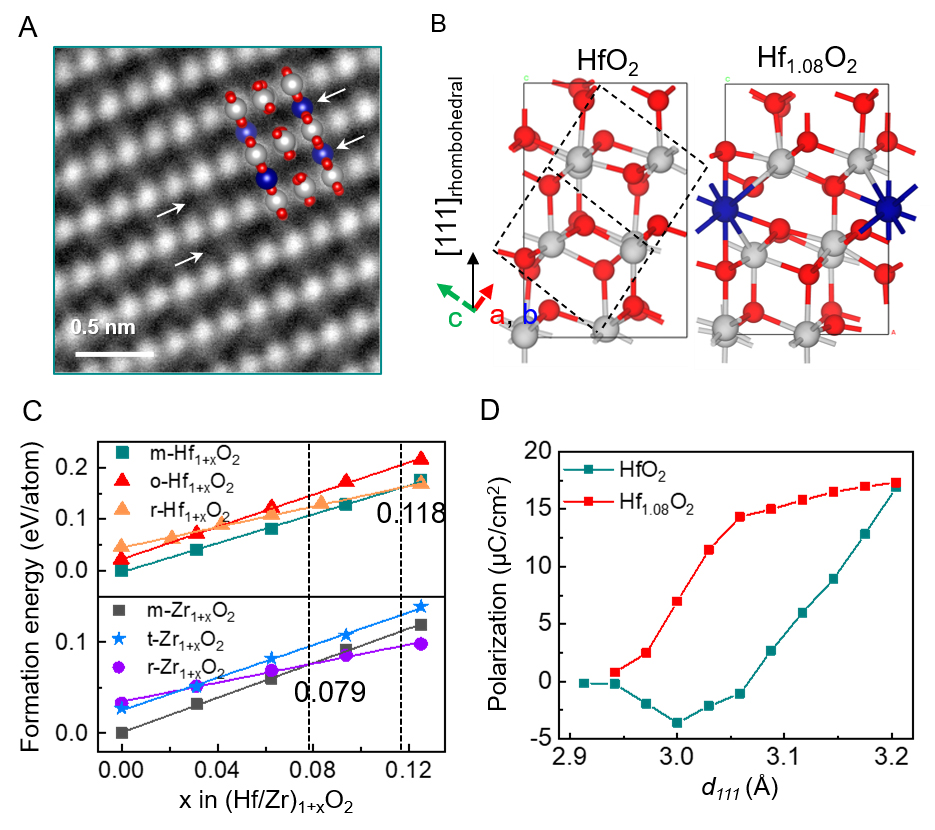Hafnium oxide-based ferroelectric materials are promising candidates for next-generation nanoscale devices due to their integration into silicon electronics.
In a study published in Science, researchers from the Institute of Microelectronics of the Chinese Academy of Sciences (IMECAS) and the Institute of Physics of CAS made the discovery of a stable rhombohedral ferroelectric Hf(Zr)1+xO2 which exhibits an ultra-low coercive field.
The intrinsic high coercive field of the fluorite ferroelectric Hf(Zr)O2 devices leads to the incompatible operating voltage with advanced technology nodes and limited endurance. In this work, a stable ferroelectric r-phase Hf(Zr)1+xO2 material which effectively reduces the switching barrier of ferroelectric dipoles in HfO2-based materials was discovered.
Scanning transmission electron microscopy (STEM) verified the intercalation of excess Hf(Zr) atoms within the hollow sites, forming an ordered array. Density functional theory calculations (DFT) provided insights into the underlying mechanism that the intercalated atoms stabilize the ferroelectric phase and reduce its switching barrier.
The ferroelectric devices based on the r-phase Hf(Zr)1+xO2 exhibit an ultra-low coercive field (~0.65 MV/cm), a high remnant polarization (Pr) value of 22 μC/cm2, a small saturation polarization field (1.25 MV/cm) and high endurance (1012-cycles).
The work is important to realize low-cost and long-life memory chips.
Article link: https://www.science.org/doi/10.1126/science.adf6137
A stable rhombohedral phase in ferroelectric Hf(Zr)1+xO2 capacitor with ultralow coercive field
Y Wang , L Tao , R Guzman, Q Luo, W Zhou, Y Yang, Y Wei, Y Liu, P Jiang, Y Chen, Sh Lv, Y Ding, W Wei, T Gong, Y Wang, Q Liu, Sh Du, M Liu
Science (2023) DOI: 10.1126/science.adf6137

Fig. 1. Atomic-scale STEM analysis and DFT calculations of the rhombohedral phase Hf(Zr)1+xO2. (A) STEM image of Hf(Zr)1+xO2 structure showing the intercalation of the excess Hf(Zr) atoms (highlighted by the white arrows). An atomic model is overlaid to guide the eyes. Scale bar, 0.5 nm. (B), Atomic configurations of ferroelectric rhombohedral HfO2 and Hf1.08O2. The extra Hf atom is marked in blue. The dashed line is the pristine rhombohedral lattice, and the solid lines are the hexagonal lattice. The [111] direction of the rhombohedral lattice is aligned with the c axis of the hexagonal lattice. (C), Formation energy of Hf1+xO2 in r-, o- and m-phases as a function of x (upper) and Zr 1+xO2 in r-, t-, m-phases as a function of x (lower). The m-r phase transition for the binary Hf(Zr)1+xO2 occurs when the value of x is larger than 0.079. (D), Polarization of r-phase HfO2 and Hf1+xO2 as a function of d111.

Fig. 2. Ferroelectric properties of r-phase Hf(Zr)1+xO2 films. (A) PUND measurements of r-phase Hf(Zr)1+xO2 capacitors prepared with different Hf powers under an electric field of frequency 1 kHz. (B) The P-E curves of the r-phase ferroelectric Hf(Zr)1.20O2 capacitor at different electric fields. (C) The benchmarking of Hf(Zr)1+xO2 film in this work against some reported HfO2-based ferroelectric films with regard to Es. (D), I-E characteristics of o-phase Hf0.5Zr0.5O2(HZO) ferroelectric thin films and r-phase Hf(Zr)1+xO2 ferroelectric thin films. (E) The endurance properties of the r-phase ferroelectric Hf(Zr)1+xO2 capacitor. (F) The benchmarking of HZO film in this work against some reported HfO2-based ferroelectric films with regard to endurance.
Contact:
WANG Yuan
State key Lab of Fabrication Technologies for Integrated Circuits, Institute of Microelectronics, Chinese Academy of Sciences
Tel: +86-18801227120
Email: wangyuan@ime.ac.cn












